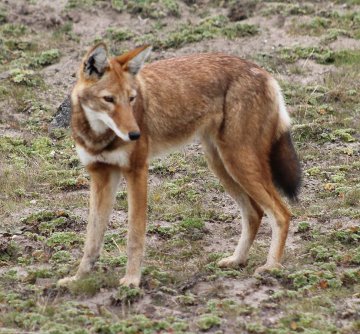Ethiopian Wolf

Ethiopian wolves are thought to have originated from the grey wolves that immigrated to Africa around a hundred thousand years ago. Ethiopian wolves are closely related to grey wolves, domestic dogs, and coyotes.
Physical Characteristics
Ethiopian Wolves are different from other wolf species in that they have a long muzzle and smaller teeth. Male wolves are considerably larger than female wolves. Males weigh between 33 and 42 pounds while females weigh between 25 and 32 pounds. Their legs are moderately longer. The color of their body is a reddish brown with white legs, undersides and markings on their face. The Ethiopian Wolves shaggy tails are black at the tip and white at the base.
Habitat
They are a localized endemic species, confined to remote regions of Afroalpine grasslands and headlands where they prey on rodents. Habitats extend from above the tree-line with some of them present in the grasslands at 9,800 feet up. Subsistence farming extends up to 11,500 feet in elevetion, confining these wolves to higher ranges. Rainfall at high altitudes ranges between 40 to 80 inches per year. The wolves make use of all landscapes, but prefer open places with short herbaceous as well as grassland communities where rodents are plentiful.
Geographical Areas
Ethiopian wolves have a restricted range. They can only be found in 6 or 7 mountain regions of Ethiopia. This comprises of the Bale and Arssi mountains of southeastern Ethiopia, northeast Shoa, Simien mountains, Gojjam, as well as Mount Guna. The biggest population lives in the Bale Mountains National Park.
Reproduction
Ethiopian wolves mate over the period of 3 to 5 days, involving the copulation tie which lasts up to fifteen minutes. Females carry their pups for about 60 to 62 days. They give birth in a den that they dig in the grounds under the rock. Once the pups are born, they are charcoal gray and are born without the teeth. When pups are 21 days old, their coat starts to be replaced by the adult coloring and the young ones start to come out of the den.
Diet
The Ethiopian wolves are generally carnivores, always preying on rodents such as hares, giant mole-rat and the common grass rats, to name a few. Also, they consume eggs, goslings and the young ungulates. They will, on occasion, eat carcasses. They also catch their prey in very shallow holes.
Behavior
An Ethiopian wolfs' dispersal movements are constrained by the scarcity of suitable habitat. Males do not wander as much as female do as they are recruited into other packs. They normally become floaters through the use of narrow ranges between pack regions till a breeding vacancy becomes available. Due to delayed dispersal, they form discrete social packs that defend an entire territory. A pack may be formed by three to thirteen adults but in less populated regions, wolves live in pairs.
Lifespan
A life span of an Ethiopian wolf in the wild is 8 to 10 years, though some Ethiopian wolves have been recorded to live for 12 years.
